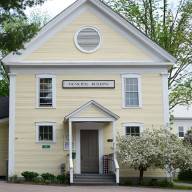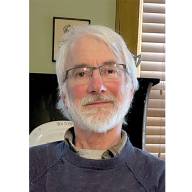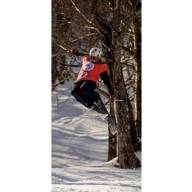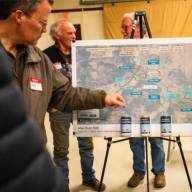The Fourth of July Part 3; Things got out of hand
By Mary Kathleen Mehuron
Charlie Brown’s 1993 documentary about the Warren Fourth of July parade is fascinating to watch. In it Jack Garvin of The Warren Store was interviewed, and he said, “I have a unique perspective in that it’s a so-called workday for me and a lot of my experiences are from being in the store and looking out. Through those large store windows, it is something like watching a Fellini movie. It’s changing constantly. It’s very entertaining. Back in the 80s, it was Mardi Gras North at the Fourth of July. Anything goes. And on this particular Fourth, I think it was 1985, I finished up after a long day.
From Vermont Public Radio: “’It was like New Orleans here,’ says Garvin. ‘It was really out of control. When the day was over, the town kind of looked like a landfill. We literally had to clean the streets with snow shovels.’
“Others harken back even further and don’t like the current iteration one bit. ‘It used to be a decent parade, but now, it’s just drugs and drink,’” says one Main Street resident, who declined to give her name. She has lived in Warren her entire life. “In the good old days there wasn’t the dancing and stuff going on down there,” she said.”
Jack Garvin continued his thoughts in Charlie’s documentary, “People lingered in the village for hours. Well after the parade. Well after the band. Continued partying and I got my little hibachi. That was the way that everybody took an hour and a half to get those coals going -- to cook two hamburgers. And right on the porch I was directly across from the gazebo in town, which was decorated, and that was the judges’ reviewing stand.
“I look across at the gazebo and there was a couple that was getting very friendly. And they were incredibly drunk and incredibly amorous. People are walking by, joking, yelling, jeering and cars were going by. There was actually a fender bender. Someone stopped, did a double take, the car right behind him plowed into his rear end.
“I looked down the street and I see Jenny Duel, Nancy Colby and one other person. They were, at the time, the three women that were part of the parade organization. They were walking up, talking amongst themselves, unaware of what was going on in the gazebo. Their plans were to take down the decorations. So, they’re about 20 or 30 feet from this couple when they all collectively realized what was going on. Neither one of them said a word. The just looked and they slowly, and in union, turned around and walked back to the Pitcher Inn.”
THE FLOATS COULD GET SKETCHY TOO
Dave Sellers had an equally outrageous tale to tell in the film. “We decided we wanted to do some marching in formation. We thought that would be cool. Because John marched in the University of Minnesota marching band. I marched in my high school marching band -- and you had to be tight.
“So, I figured the only way to get this thing tight was to tie everybody together. (He guffaws.) So, we got a bunch of strapping. We got these long 1 by 3 and every 2 feet, you built a hole, and you would stand in a square kind of thing.
“There was, like, 15 people this way and that way. Everything was filled up. I was in the front row. And there was this woman, who was apprenticing to us, she wanted to work. She was very short. She was right next to me.
“And so, we decided this wasn’t good enough. We had to do something more amazing. So, we got some black plastic. Polyethylene. We draped it over everyone and cut holes, so your head was sticking out.
“That was our float. Thirty heads wrapped in black plastic. And then we would do stuff like, someone would say, “Down,” and we would go down. Then we would go up and then we would rotate and then we would wiggle. You know? That was our idea. That was the whole theme.
“Plus. John and I were playing Yankee Doodle in the front. Then pop and the whole thing would go down, “Pop goes the weasel.”
“And everyone one loved it because it was a float -- something was happening.
So, we got to the covered bridge. We’d gone through the whole thing. It was really hot. Roth and I were leading it. And I said, “Why don’t we just go in the river. Take our float right in the Mad River behind the covered bridge. Because everyone was tied together, nobody could get out of this thing. (Hysterical laughter.)
“We go down this little hill. It almost tips over and some people would trip and get back up. We get in the river and the water is up to our knees. And we go along, still playing Pop Goes the Weasel and Yankee Doodle. And everyone was really happy, it was really great but, all of the sudden, we ran into a hole.
“It was about an 8-foot-deep hole in the river. And this woman next to me sank out of sight. She’s gone. Where is she? Everyone is looking around to see what happened to her. She’s gone like four or five people down. (The current of the river pushed her further under the wooden grid they built, and the people above trapped her. It must also have been very dark because of the black plastic.)
“Someone yelled, ‘Oh my God, it’s a shark.” Something bothering somebody. They pulled her up. She was okay.
“That was the last time we went in the river.”
LIKE NEW ORLEANS
I’ll just remind the readers of our paper that I came to the Valley in 1987. Even to me who had entered high school two years after the Summer of Love, spent much of my young life in New York City and was a cocktail waitress at a Key Club during the height of the Disco era -- the scene at the parade was a bit of a shock. A lot of fellow parents of young children were a bit older than me and had participated fully in the cultural revolution of the 1960s, the mantra being, drugs, sex and rock n’ roll. Priority given, by the 90s, to the drugs part. It surprised me that these parents smoked marijuana openly in Warren, even in front of their children.
And the drinking at the parade started early. Because you had to come early to secure a good place to sit. Coolers and lawn chairs as far as the eye can see. Because great music was sure to follow the parade (and I very much like to dance and have a drink, truth be told), I got into the spirit of the thing. But, as Jack Garvin said, “It was really out of control.” And it went on this way for many, many years.
George Schenk of American Flatbread fame was interviewed in Charlie Brown’s film as well.
“The parade seemed like it was in a state of crisis. People didn’t quite know what to do. I wound up getting together with Robin Morris and Sucosh Norton [John H. Norton] and we talked about what the parade could be and needed to be. The more we thought about it, the more we realized that the parade was the rightful responsibility of the town rather than one business within the town.” (The Warren Store.)
Pam Rickard, the daughter of the owner of The Warren Store, remembers this dilemma well. Her mother was also seeking ways to tamp down the extreme partying. Her first response was to consider stop selling alcohol.
George’s interview continued, “So we started looking at how we might fund it without using a lot of tax money, and still make it great. And take the cost responsibilities away from The Warren Store. In turn The Warren Store wouldn’t sell any alcohol. That was going to be the deal.
“So, the town took on the cost of the band and the port-o-potties, the trash removal and the security. That’s when we initiated the $1, I think it is, the buddy badge system. And it was also felt that we needed to change people’s expectations about what the parade was. It had become this big bash. And it was great as a big bash for a long time but then it didn’t work.
“And so, it was my idea to create a series of banners that would decorate the town. And with a language that helped reorient the expectations, and the values and the ideas behind the parade. And to refocus it on more of a community celebration.”
But George said this in 1993, and change would be slow to come, despite their best efforts. People continued to bring their own alcohol in coolers to drink while they waited for the parade to start. On July 4, 1996, the worst possible outcome came to pass.
Patricia Warner was driving her son, Michael, and their friend, Joshua Smith, into Waitsfield. Both the boys were 16 years old. Also in Warner’s car was 12-year-old Christopher Stewart. They were struck by a vehicle driven by 19-year-old Joshua Nelson who had been drinking at the parade. Police said Nelson traveled across the center line when he hit Patricia’s car.
Nelson had one passenger in his truck at the time of impact, Joseph Bishop, age 20.
Warner and her son, Michael, were pronounced dead at the scene. Smith, Stewart, Nelson, and Bishop were taken to Fletcher Allen Health Care in Burlington where Joshua Smith later died of his injuries.
Nelson was sentenced to three to 30 years with all but three suspended.
Six people’s lives were changed forever that day -- in a heartbeat. And three of them are gone to us.
Next time we will find a reflective community that comes together to create a different kind of celebration.













